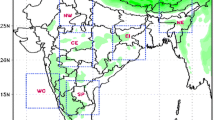Realistic simulation/prediction of the Asian summer monsoon rainfall on various space–time scales is a challenging scientific task. Compared to mid-latitudes, a proportional skill improvement in the prediction of monsoon rainfall in the medium range has not happened in recent years. Global models and data assimilation techniques are being improved for monsoon/tropics. However, multi-model ensemble (MME) forecasting is gaining popularity, as it has the potential to provide more information for practical forecasting in terms of making a consensus forecast and handling model uncertainties. As major centers are exchanging model output in near real-time, MME is a viable inexpensive way of enhancing the forecasting skill and information content. During monsoon 2008, on an experimental basis, an MME forecasting of large-scale monsoon precipitation in the medium range was carried out in real-time at National Centre for Medium Range Weather Forecasting (NCMRWF), India. Simple ensemble mean (EMN) giving equal weight to member models, bias-corrected ensemble mean (BCEMn) and MME forecast, where different weights are given to member models, are the products of the algorithm tested here. In general, the aforementioned products from the multi-model ensemble forecast system have a higher skill than individual model forecasts. The skill score for the Indian domain and other sub-regions indicates that the BCEMn produces the best result, compared to EMN and MME. Giving weights to different models to obtain an MME product helps to improve individual member models only marginally. It is noted that for higher rainfall values, the skill of the global model rainfall forecast decreases rapidly beyond day-3, and hence for day-4 and day-5, the MME products could not bring much improvement over member models. However, up to day-3, the MME products were always better than individual member models.
Similar content being viewed by others
References
Bowler N E, Arribas A, Mylne K R, Robertson K B and Beare S E 2008 The MOGREPS short range ensemble prediction system; Quart. J. Roy. Meteor. Soc. 134 703–722.
Cartwright T J and Krishnamurti T N 2007 Warm season mesoscale superensemble precipitation forecasts in the southeastern United States; Weather Forecast. 22 873–886.
Cusack S and Arribas A 2008 Assessing the usefulness of probabilistic forecasts; Mon. Weather Rev. 136 1492–1504.
Ebert E E 2001 Ability of a poor man’s ensemble to predict the probability and distribution of precipitation; Mon. Weather Rev. 129 2461–2480.
Ebert E E, Janowiak J and Kidd C 2007 Comparison of near real time precipitation estimates from satellite observations and numerical models; Bull. Am. Meteorol. Soc. 88 47–64.
Evans R E, Harrison M S J, Graham R J and Mylne K R 2000 Joint medium-range ensembles from the Met. Office and ECMWF system; Mon. Weather Rev. 128 3104–3127.
Gadgil S 2003 The Indian monsoon and its variability; Annu. Rev. Earth Planet. Sci. 31 429–467.
Hamill T M, Hagedorn R and Whitaker J S 2008 Probabilistic forecast calibration using ECMWF and GFS ensemble forecasts, part II: precipitation; Mon. Weather Rev. 136 2620–2632.
Johnson C and Swinbank R 2009 Medium-range multimodel ensemble combination and calibration; Quart. J. Roy. Meteor. Soc. 135 777–794.
Krishnamurti T N, Kishtawal C M, LaRow T E, Bachiochi D R, Zhang Z, Williford C E, Gadgil S and Surendran S 1999 Improved weather and seasonal climate forecasts from multi-model super-ensemble; Science 285 1548–1550.
Krishnamurti T N, Kishtawal C M, Shin D W and Williford C E 2000 Improving tropical precipitation forecasts from a multi-analysis super-ensemble; J. Climate 13 4217–4227.
Krishnamurti T N, Vijaya Kumar T S, Yun W T, Chakraborty A and Stefanova L 2006a Weather and seasonal climate forecasts using the superensemble approach; In: Predictability of Weather and Climate (eds) Tim Palmer and Renate Hagedorn (ECMWF), Cambridge University Press, pp. 532–560.
Krishnamurti T N, Vijay Kumar T S and Mitra A K 2006b Seasonal climate prediction of Indian summer monsoon; In: The Asian Monsoons (ed.) Bin Wang, pp. 553– 582.
Krishnamurti T N, Mishra A K, Chakraborty A and Rajeevan M 2009 Improving Global Model Precipitation Forecasts over India using downscaling and the FSU superensemble. Part I: 1–5-Day forecasts; Mon. Weather Rev. 137(9) 2713–2735.
Mishra A K and Krishnamurti T N 2007 Current status of multi-model super-ensemble operational NWP forecast of the Indian summer monsoon; J. Earth Syst. Sci. 116(5) 1–16.
Mitra A K, Dasgupta M, Singh S V and Krishnamurti T N 2003 Daily rainfall for Indian monsoon region from merged satellite and raingauge values: Large-scale analysis from real-time data; J. Hydrometeorol. (AMS) 4(5) 769–781.
Mylne K R, Evans R E and Clark R T 2002 Multi-model multi-analysis ensembles in quasi-operational medium-range forecasting; Quart. J. Roy. Meteor. Soc. 128 261–384.
Richardson D S 2001 Ensembles using multiple models and analyses; Quart. J. Roy. Meteor. Soc. 127 1847–1864.
Roy Bhowmik S K and Durai V R 2008 Multi-model ensemble forecasting of rainfall over Indian monsoon region; Atmosfera 21(3) 225–239.
Roy Bhowmik S K and Durai V R 2010 Application of multi-model ensemble techniques for real time district level rainfall forecasts in short range time scale over Indian region; MAP 106(1–2) 19–35.
Webster P J, Magana V O, Palmer T N, Shukla J, Tomas R A, Yanai M and Yasunari T 1998 Monsoons: Processes, predictibility and the prospects for prediction; J. Geophys. Res. 103C 14,451–14,510.
Whitaker J S, Wei X and Vitart F 2006 Improving week-2 forecasts with multimodel reforecast ensembles; Mon. Weather Rev. 134 2279–2284.
Woodcock F and Engel C 2005 Operational consensus forecasts; Weather Forecast. 20 101–111.
Woods A 2006 Medium range weather prediction (USA: Springer Publications) 261 pp.
Author information
Authors and Affiliations
Corresponding author
Rights and permissions
About this article
Cite this article
MITRA, A.K., IYENGAR, G.R., DURAI, V.R. et al. Experimental real-time multi-model ensemble (MME) prediction of rainfall during monsoon 2008: Large-scale medium-range aspects. J Earth Syst Sci 120, 27–52 (2011). https://doi.org/10.1007/s12040-011-0013-5
Received:
Revised:
Accepted:
Published:
Issue Date:
DOI: https://doi.org/10.1007/s12040-011-0013-5




